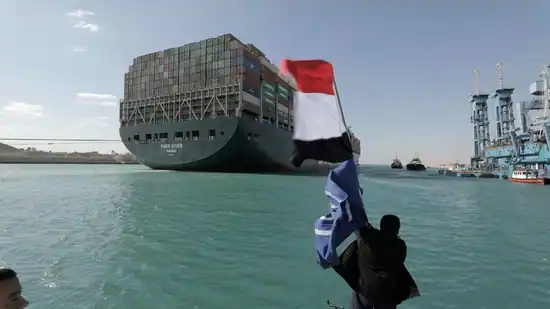Experts on Tuesday boarded a colossal container ship that had been stuck for nearly a week in the Suez Canal before it was freed as questions swirled about the grounding that had shaken the global shipping industry and clogged one of the world’s most vital waterways.
The Ever Given was anchored in the Great Bitter Lake, a wide stretch of water halfway between the north and south ends of the canal, after salvage teams succeeded in finally freeing the skyscraper-size vessel on Monday afternoon. The ship, stuck sideways in a narrow stretch of the canal, had halted billions of dollars a day in maritime commerce.
A senior canal pilot, speaking on condition of anonymity because he was not authorized to talk to journalists, told The Associated Press the experts were looking for signs of possible damage and trying to determine the cause of the vessel’s grounding.
Engineers were examining the engines of the Panama-flagged, Japanese-owned ship hauling goods from Asia to Europe to determine when exactly it can sail to its destination in the Netherlands, he said without elaborating.
Ships stacked with containers could be seen from the city of Suez, sailing in the north-bound part of the waterway. Suez Canal service provider Leth Agencies said that over three dozen vessels that had waited for Ever Given to be freed, have already exited the canal into the Red Sea since the waterway was reopened for navigation at 6 p.m. on Monday.
The shipowner, Shoei Kisen, said Tuesday that it will be part of the investigation, which would also include other parties, though it did not identify them by name. It also refused to discuss possible causes of the accident, including the alleged high speed and other errors, saying that it cannot comment on the investigation that is still going on.
The company added that any damage to the ship was believed to be mostly on the bottom. Shoei Kisen said it was not immediately known whether the vessel will be repaired on site in Egypt or elsewhere, or whether it will eventually head to its initial destination of Rotterdam. That is a decision to be made by its operator, rather than the shipowner, the company said.
On Monday, a flotilla of tugboats, helped by the tides, wrenched the bulbous bow of Ever Given from the canal’s sandy bank, where it had been firmly lodged since March 23. The tugs blared their horns in jubilation as they guided the Ever Given through the water after days of futility that had captivated the world, drawing scrutiny and social media ridicule.
Analysts expect it could take at least another 10 days to clear the backlog on either end of the Suez Canal.
The Ever Given had crashed last Tuesday into a bank of a single-lane stretch of the canal about 6 kilometers (3.7 miles) north of the southern entrance, near the city of Suez. That created a massive traffic jam that held up $9 billion a day in global trade and strained supply chains already burdened by the coronavirus pandemic.
At least 367 vessels, carrying everything from crude oil to cattle, had backed up to wait to traverse the canal. Dozens of others have taken the long, alternate route around the Cape of Good Hope at Africa’s southern tip — a 5,000-kilometer (3,100-mile) detour that costs ships hundreds of thousands of dollars in fuel and other costs.
The canal is a source of national pride and crucial revenue for Egypt, and President Abdel Fattah el-Sissi praised Monday’s events after days of silence about the blockage.
“Egyptians have succeeded in ending the crisis,” he wrote on Facebook, “despite the massive technical complexity.”
The crisis over the Ever Given had cast a spotlight on the vital trade route that carries over 10% of global trade, including 7% of the world’s oil. Over 19,000 ships ferrying Chinese-made consumer goods and millions of barrels of oil and liquified natural gas flow through the artery from the Middle East and Asia to Europe and North America.
The unprecedented shutdown, which raised fears of extended delays, goods shortages and rising costs for consumers, has prompted new questions about the shipping industry, an on-demand supplier for a world under pressure from the pandemic.

